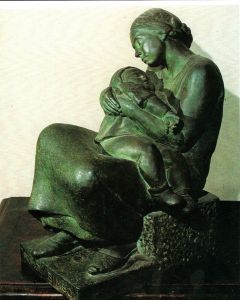Sculptor and Painter
 Franco Bargiggia was born in Milan on 10 October 1888.
Franco Bargiggia was born in Milan on 10 October 1888.
He was enrolled at the Brera Academy of Fine Arts and obtained a diploma with full marks, exhibiting at the National Sculpture Exhibition in Milan "il dolore" a work with which he received his first great recognition in the artistic field.
In the first post-war period his production was oriented towards works of a social character. In 1926 he was awarded the Gold Medal for artistic merit by the Ministry of Education.
He fell ill with a serious form of arthrosis and in 1930 he moved with his wife to Sanremo in a large house with a terrace overlooking the sea between Capo Marina and Capo dell'Arma. In 1931 he took part in the first Art Exhibition of Sanremo Artists at Villa Ormond with four works.
In 1931 he took part in the first Art Exhibition of Sanremo Artists at Villa Ormond with four works.
Since then Sanremo became his adoptive city where he could dedicate himself to his vast production, which made him famous, allowing him to participate in numerous painting competitions and win as many prizes.
A sculptural group of that period "the child and the turtle" was purchased by the Municipality of Sanremo in 1988.
The years between 1925 and 1935 marked the period of his full artistic maturity with a series of works characterised by late-liberty accents and references to a taste that was still nineteenth-century. ( see the works: The Shawl Dance and Voluptuousness ).
The following works are linked to the world of childhood and maternity, themes dear to the regime, such as Tenderness of Mother (1938) Maternal Embrace and Mother and Child: they can be seen in the Museum and in the Town Hall.
The period of the war also marked the most painful period for the artist, he was left by his wife, went to live in Via Rivolte San Sebastiano, wandered to Milan to merge some of his works, and only in the company of his granddaughter, he experienced a period of dramatic material deprivation, comforted by a few friends and the parish priest Don Cortona, while his arthritis became worse and worse.
He died in the hospital of Sanremo on 18th March 1966.
After the war, his fame spread further and he continued his work and obtained further recognition on the Riviera and in Rome where he became a member of the Accademia Tiberina.
(Source Andrea Gandolfo)




